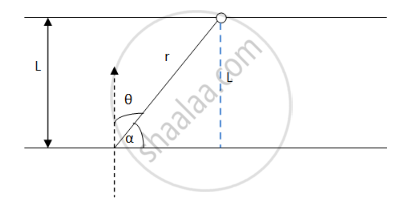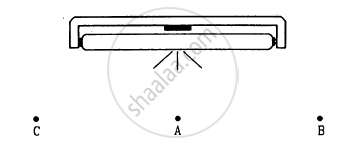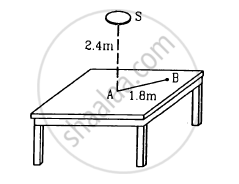Advertisements
Advertisements
प्रश्न
A point source of light moves in a straight line parallel to a plane table. Consider a small portion of the table directly below the line of movement of the source. The illuminance at this portion varies with its distance r from the source as ___________ .
विकल्प
\[1 \propto \frac{1}{r}\]
\[1 \propto \frac{1}{r^2}\]
\[1 \propto \frac{1}{r^3}\]
\[1 \propto \frac{1}{r^4}\]
उत्तर
\[1 \propto \frac{1}{r^3}\]

Let the distance between the parallel straight lines be L.
Angle with normal = θ
We know,
\[I = \frac{I_o \cos\theta}{r^2}\]
From the above figure, we get
\[I = \frac{I_o \cos\left( {90}^0 - \alpha \right)}{r^2}\]
\[ \Rightarrow I = \frac{I_o \sin\alpha}{r^2}\]
\[ \Rightarrow I = \frac{I_o}{r^2}\left( \frac{L}{r} \right)\]
\[ \Rightarrow I = \frac{I_o L}{r^3}\]
L = constant for parallel moving source
So, \[I_o L = k ............\left(\text{constant}\right)\]
\[ \Rightarrow I = \frac{k}{r^3}\]
\[ \Rightarrow I\alpha\frac{1}{r^3}\]
APPEARS IN
संबंधित प्रश्न
What is the luminous flux of a source emitting radio waves?
The luminous flux of a 1 W sodium vapour lamp is more than that of a 10 kW source of ultraviolet radiation. Comment.
The one parameter that determines the brightness of a light source sensed by an eye is ____________ .
Light from a point source falls on a screen. If the separation between the source and the screen is increased by 1%, the illuminance will decrease (nearly) by ____________ .
The intensity produced by a long cylindrical light source at a small distance r from the source is proportional to _________ .
Figure shows a glowing mercury tube. The intensities at point A, B and C are related as __________ .

The brightness-producing capacity of a source
(a) does not depend on its power
(b) does not depend on the wavelength emitted
(c) depends on its power
(d) depends on the wavelength emitted
A room is illuminated by an extended source. The illuminance at a particular portion of a wall can be increased by
(a) moving the source
(b) rotating the source
(c) bringing some mirrors in proper positions
(d) changing the colour of the source.
A photographic plate records sufficiently intense lines when it is exposed for 12 s to a source of 10 W. How long should it be exposed to a 12 W source radiating the light of same colour to get equally intense lines?
A point source emitting 628 lumen of luminous flux uniformly in all directions is placed at the origin. Calculate the illuminance on a small area placed at (1.0 m, 0, 0) in such a way that the normal to the area makes an angle of 37° with the X-axis.
The illuminance of a small area changes from 900 lumen m−2 to 400 lumen m−2 when it is shifted along its normal by 10 cm. Assuming that it is illuminated by a point source placed on the normal, find the distance between the source and the area in the original position.
A point source emitting light uniformly in all directions is placed 60 cm above a table-top. The illuminance at a point on the table-top, directly below the source, is 15 lux. Find the illuminance at a point on the table-top 80 cm away from the first point.
A student is studying a book placed near the edge of a circular table of radius R. A point source of light is suspended directly above the centre of the table. What should be the height of the source above the table so as to produce maximum illuminance at the position of the book?
Figure shows a small diffused plane source S placed over a horizontal table-top at a distance of 2.4 m with its plane parallel to the table-top. The illuminance at the point Adirectly below the source is 25 lux. Find the illuminance at a point B of the table at a distance of 1.8 m from A.

An electric lamp and a candle produce equal illuminance at a photometer screen when they are placed at 80 cm and 20 cm from the screen respectively. The lamp is now covered with a thin paper which transmits 49% of the luminous flux. By what distance should the lamp be moved to balance the intensities at the screen again?
Light rays from a point object ______.
Light travels through a glass plate of thickness t and having a refractive index μ. If c is the velocity of light in vacuum, the time taken by the light to travel this thickness of glass is ______.
